Coupling Relationship between Urban Expansion and Lake Change—A Case Study of Wuhan
Abstract
:1. Introduction
2. Materials and Methods
2.1. Study Area
2.2. Data Preparation and Preconditioning
2.2.1. Data Collection
2.2.2. Lake Data Extraction
2.2.3. Data Extraction of Urban Built-up Area
2.3. Data Processing Methods
2.3.1. Calculation of Lake Change Index
2.3.2. Calculation of Urban Expansion Rate
2.3.3. Data Standardisation Process
2.3.4. Establishment of the Lake Evaluation Model
2.3.5. Coupling Analysis
3. Results
3.1. Results of Lake Changes
3.2. Results of Urban Boundary Changes in Wuhan
3.3. Case Analysis of Tangxun Lake
3.4. Results of Coupling Relationship
3.5. Result Analysis
3.5.1. Lakes
3.5.2. Built-Up Areas
3.5.3. Coupling Degree
4. Conclusions
Author Contributions
Funding
Conflicts of Interest
References
- Siegel, F.R. Population assessments: 2013–2050–2100: Growth, stability, contraction. In Countering 21st Century Social-Environmental Threats to Growing Global Populations; Springer: Cham, Switzerland, 2015; pp. 1–8. [Google Scholar]
- Zheng, B.; Myint, S.W.; Fan, C. Spatial configuration of anthropogenic land cover impacts on urban warming. Landsc. Urban Plan. 2014, 130, 104–111. [Google Scholar] [CrossRef]
- Dou, Y.; Liu, Z.; He, C. Urban land extraction using VIIRS nighttime light data: An evaluation of three popular methods. Remote Sens. 2017, 9, 175. [Google Scholar] [CrossRef]
- He, J.; Wang, S.; Liu, Y. Examining the relationship between urbanization and the eco-environment using a coupling analysis: Case study of Shanghai, China. Ecol. Indic. 2017, 77, 185–193. [Google Scholar] [CrossRef]
- Wang, S.J.; Ma, H.; Zhao, Y.B. Exploring the relationship between urbanization and the eco-environment—A case study of Beijing–Tianjin–Hebei region. Ecol. Indic. 2014, 45, 171–183. [Google Scholar] [CrossRef]
- Zhao, Y.; Wang, S.; Zhou, C. Understanding the relation between urbanization and the eco-environment in China Yangtze River Delta using an improved EKC model and coupling analysis. Sci. Total Environ. 2016, 571, 862–875. [Google Scholar] [CrossRef] [PubMed]
- Chai, J.; Wang, Z.; Zhang, H. Integrated evaluation of coupling coordination for land use change and ecological security: A case study in Wuhan city of Hubei province, China. Int. J. Environ. Res. Public Health 2017, 14, 1435. [Google Scholar] [CrossRef] [PubMed]
- López, E.; Bocco, G.; Mendoza, M. Predicting land-cover and land-use change in the urban fringe: A case in Morelia city, Mexico. Landsc. Urban Plan. 2001, 55, 271–285. [Google Scholar] [CrossRef]
- Xiao-Peng, S.; Hansen, M.C.; Stehman, S.V. Global land change from 1982 to 2016. Nature 2018, 560, 639. [Google Scholar]
- Jiyuan, L.; Jia, N.; Wenhui, K. Spatio-temporal patterns and characteristics of land-use change in China during 2010-2015. J. Geogr. Sci. 2018, 28, 547–562. [Google Scholar]
- Li, G.; Sun, S.; Fang, C. The varying driving forces of urban expansion in China: Insights from a spatial-temporal analysis. Landsc. Urban Plan 2018, 174, 63–77. [Google Scholar] [CrossRef]
- Wang, J.; Lin, Y.; Glendinning, A. Land-use changes and land policies evolution in China’s urbanization processes. Land Use Policy 2018, 75, 375–387. [Google Scholar] [CrossRef]
- Liu, Y.; Huang, X.; Yang, H. Environmental effects of land-use/cover change caused by urbanization and policies in Southwest China Karst area—A case study of Guiyang. Habitat Int. 2014, 44, 339–348. [Google Scholar] [CrossRef]
- Xie, C.; Huang, X.; Wang, L. Spatiotemporal change patterns of urban lakes in China’s major cities between 1990 and 2015. Int. J. Digit. Earth 2018, 11, 1085–1102. [Google Scholar] [CrossRef]
- Ke, Y.; Gong-Hao, D.; Rui-Qing, N. Analysis of lake changes in Wuhan based on multi-source remote sensing data. J. Yangtze River Sci. Res. Inst. 2016, 33, 139–142, 146. [Google Scholar]
- Yue, D.; Weiguo, J.; Zhenghong, T. Spatio-temporal change of lake water extent in Wuhan urban agglomeration based on landsat images from 1987 to 2015. Remote Sens. 2017, 9, 270. [Google Scholar]
- Jianfeng, Z.; Qiuwen, Z.; Zhong, T. Impact analysis of lakefront land use changes on lake area in Wuhan, China. Water 2015, 7, 4869–4886. [Google Scholar]
- Li, Y.; Li, Y.; Zhou, Y. Investigation of a coupling model of coordination between urbanization and the environment. J. Environ. Manag. 2012, 98, 127–133. [Google Scholar] [CrossRef] [PubMed]
- Chuanglin, F.; Jing, W. A Theoretical analysis of interactive coercing effects between urbanization and eco-environment. Chin. Geogr. Sci. 2013, 23, 147–162. [Google Scholar]
- Xing, L.; Xue, M.; Hu, M. Dynamic simulation and assessment of the coupling coordination degree of the economy–resource–environment system: Case of Wuhan City in China. J. Environ. Manag. 2019, 230, 474–487. [Google Scholar] [CrossRef]
- Nana, L.; Chuanzhe, L.; Yufei, X. Examining the coordination between urbanization and eco-environment using coupling and spatial analyses: A case study in China. Ecol. Indic. 2018, 93, 1163–1175. [Google Scholar]
- Yu, S.; Yin, C.; Huixia, H. An empirical analysis of the coupling coordination among decomposed effects of urban infrastructure environment benefit: Case study of four Chinese autonomous municipalities. Math. Probl. Eng. 2016, 2016, 1–11. [Google Scholar]
- Zhou, K.; Liu, Y.; Tan, R. Urban dynamics, landscape ecological security, and policy implications: A case study from the Wuhan area of central China. Cities 2014, 41, 141–153. [Google Scholar] [CrossRef]
- Yan, L.; Kun, Z.; Jingyun, F. Land use change in urban lake watershed—A case study at Donghu Lake, Wuhan. Resour. Environ. Yangtze Basin 2004, 13, 229–233. [Google Scholar]
- Gonghao, D.; Ruiqing, N. Lake area analysis using exponential smoothing model and long time-series landsat images in Wuhan, China. Sustainability 2018, 10, 149. [Google Scholar]
- Zhong, H. Study on the Model of Public Participation in Lakes Protection in Wuhan City, China—An Example of “Love Our 100 Lakes” Volunteer Action. Adv. Environ. Prot. 2018, 8, 1–12. (In Chinese) [Google Scholar]
- Zhao, S.; Zhou, D.; Zhu, C. Rates and patterns of urban expansion in China’s 32 major cities over the past three decades. Landsc. Ecol. 2015, 30, 1541–1559. [Google Scholar] [CrossRef]
- Kuang, W.H.; Chen, L.J.; Liu, J.Y. Remote sensing-based artificial surface cover classification in Asia and spatial pattern analysis. Sci. China Earth Sci. 2016, 59, 1720–1737. [Google Scholar] [CrossRef]
- Kuang, W.H.; Liu, J.Y.; Zhang, Z.X. Spatiotemporal dynamics of impervious surface areas across China during the early 21st century. Chin. Sci. Bull. 2013, 58, 1691–1701. [Google Scholar] [CrossRef]
- Liu, Z.; Wang, Y.; Li, Z. Impervious surface impact on water quality in the process of rapid urbanization in Shenzhen, China. Environ. Earth Sci. 2013, 68, 2365–2373. [Google Scholar] [CrossRef]
- Yun, D.; Yihang, Z.; Feng, L. Water Bodies’ mapping from sentinel-2 imagery with modified normalized difference water index at 10-m spatial resolution produced by sharpening the SWIR band. Remote Sens. 2016, 8, 354. [Google Scholar]
- Peng, J.; Hu, Y.; Liu, Y. A new approach for urban-rural fringe identification: Integrating impervious surface area and spatial continuous wavelet transform. Landsc. Urban Plan. 2018, 175, 72–79. [Google Scholar] [CrossRef]
- Zhang, L.; Weng, Q. Annual dynamics of impervious surface in the Pearl River Delta, China, from 1988 to 2013, using time series landsat imagery. ISPRS J. Photogramm. Remote Sens. 2016, 113, 86–96. [Google Scholar] [CrossRef]
- Sun, G.; Chen, X.; Jia, X. Combinational build-up index (CBI) for effective impervious surface mapping in urban areas. IEEE J. Sel. Top. Appl. Earth Obs. Remote Sens. 2017, 9, 2081–2092. [Google Scholar] [CrossRef]
- Genyun, S.; Xiaolin, C.; Jinchang, R. Stratified spectral mixture analysis of medium resolution imagery for impervious surface mapping. Int. J. Appl. Earth Obs. Geoinformation 2017, 60, 38–48. [Google Scholar] [Green Version]
- Zanotta, D.C.; Haertel, V.; Shimabukuro, Y.E. Linear spectral mixing model for identifying potential missing endmembers in spectral mixture analysis. IEEE Trans. Geosci. Remote Sens. 2014, 52, 3005–3012. [Google Scholar] [CrossRef]
- Jian, P.; Yanxu, L.; Hong, S. Using impervious surfaces to detect urban expansion in Beijing of China in 2000s. Chin Geogr. Sci. 2016, 26, 229–243. [Google Scholar] [CrossRef] [Green Version]
- Seto, K.C.; Fragkias, M.; Güneralp, B. A meta-analysis of global urban land expansion. PLoS ONE 2011, 6, e23777. [Google Scholar] [CrossRef] [PubMed]
- Jing, G.; Fu-You, G.; Cai, C. The spatio-temporal evolution characteristics of urbanization spatial differentiation in northeast China. Sci. Geogr. Sin. 2015, 35, 565–574. [Google Scholar]
- Liu, X.; Liang, X.; Li, X. A future land use simulation model (FLUS) for simulating multiple land use scenarios by coupling human and natural effects. Landsc. Urban Plan. 2017, 168, 94–116. [Google Scholar] [CrossRef]
- Zhang, L.; Peng, J.; Liu, Y. Coupling ecosystem services supply and human ecological demand to identify landscape ecological security pattern: A case study in Beijing–Tianjin–Hebei region, China. Urban Ecosyst. 2016, 20, 1–14. [Google Scholar] [CrossRef]
- Yi, Y.; Fei, X.; Yun, D. Construction of lake bathymetry from MODIS satellite data and GIS from 2003 to 2011. Chin. J. Oceanol. Limnol. 2014, 32, 720–731. [Google Scholar]
- Huang, W. Retrospect and Consideration on Mountain Protection of Natural Lakes in Wuhan City, Urban Age, Collaborative Planning-2013 Annual Conference of Urban Planning in China, Qingdao, Shandong, China, 16 November 2013; Qingdao Publishing House: Qingdao, China, 2013. (In Chinese) [Google Scholar]
- Chen, L.; Wang, M.; Deng, R. Discussion on assignment of legal liability in local water resources protection legislation. Yangtze River. 2018, 49, 11–14. (In Chinese) [Google Scholar]
- Fu, X. Flood Control Situation and Urban Flood Control Construction in Wuhan. Urban Road Bridge Flood Control 2000, 1, 30–35. (In Chinese) [Google Scholar]
- Tang, X.; Zhao, W.; Tang, W.; Yu, Z.; Li, H. Studies on integration of river basin management with river chief system. China Water Resour. 2018, 10, 12–14. (In Chinese) [Google Scholar]
- Zhang, F. Promoting the Co-governance of the four rivers to build a waterfront ecological green city. Yangtze River Forum. 2017, 2, 11–20. (In Chinese) [Google Scholar]
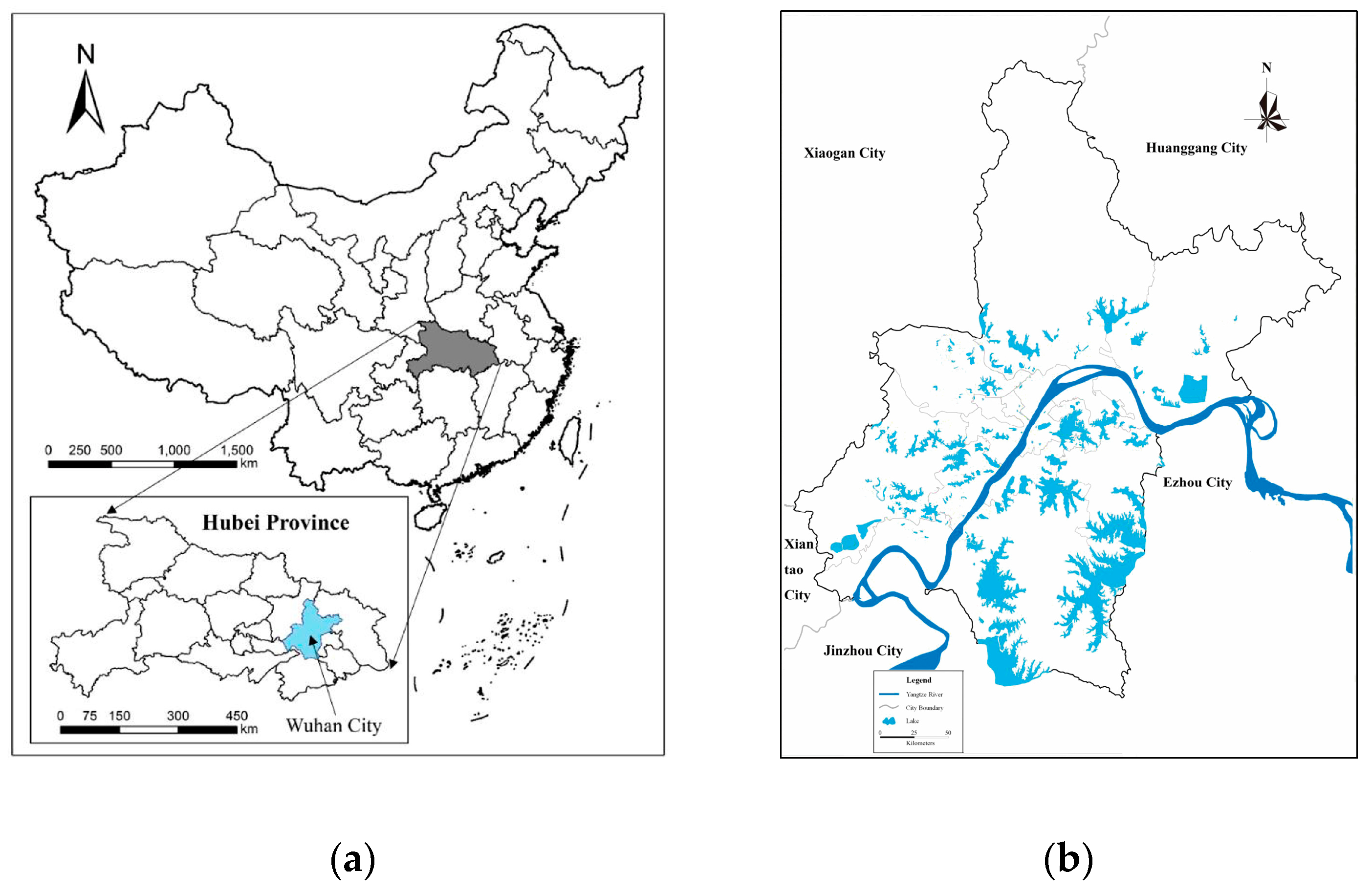
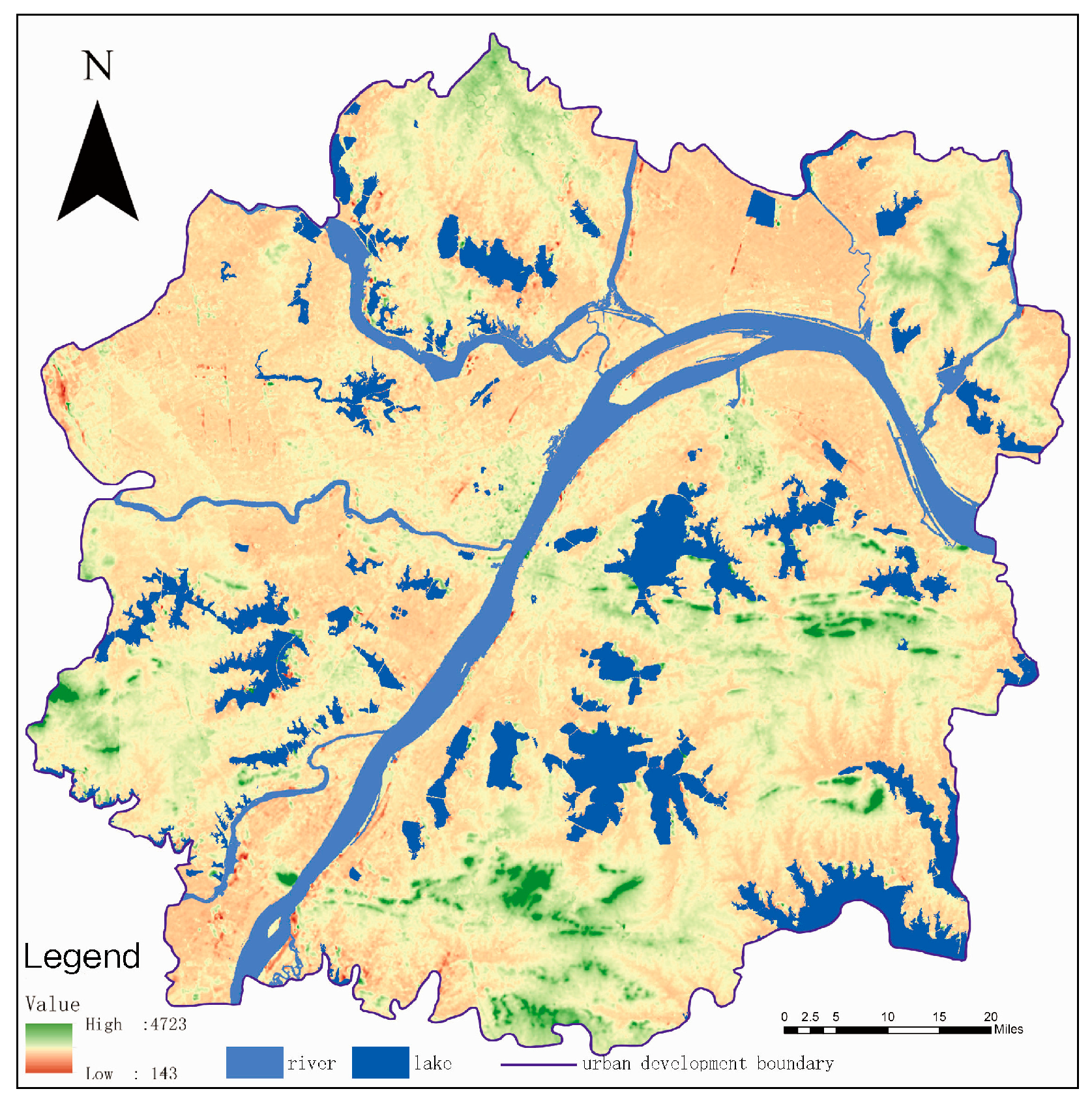

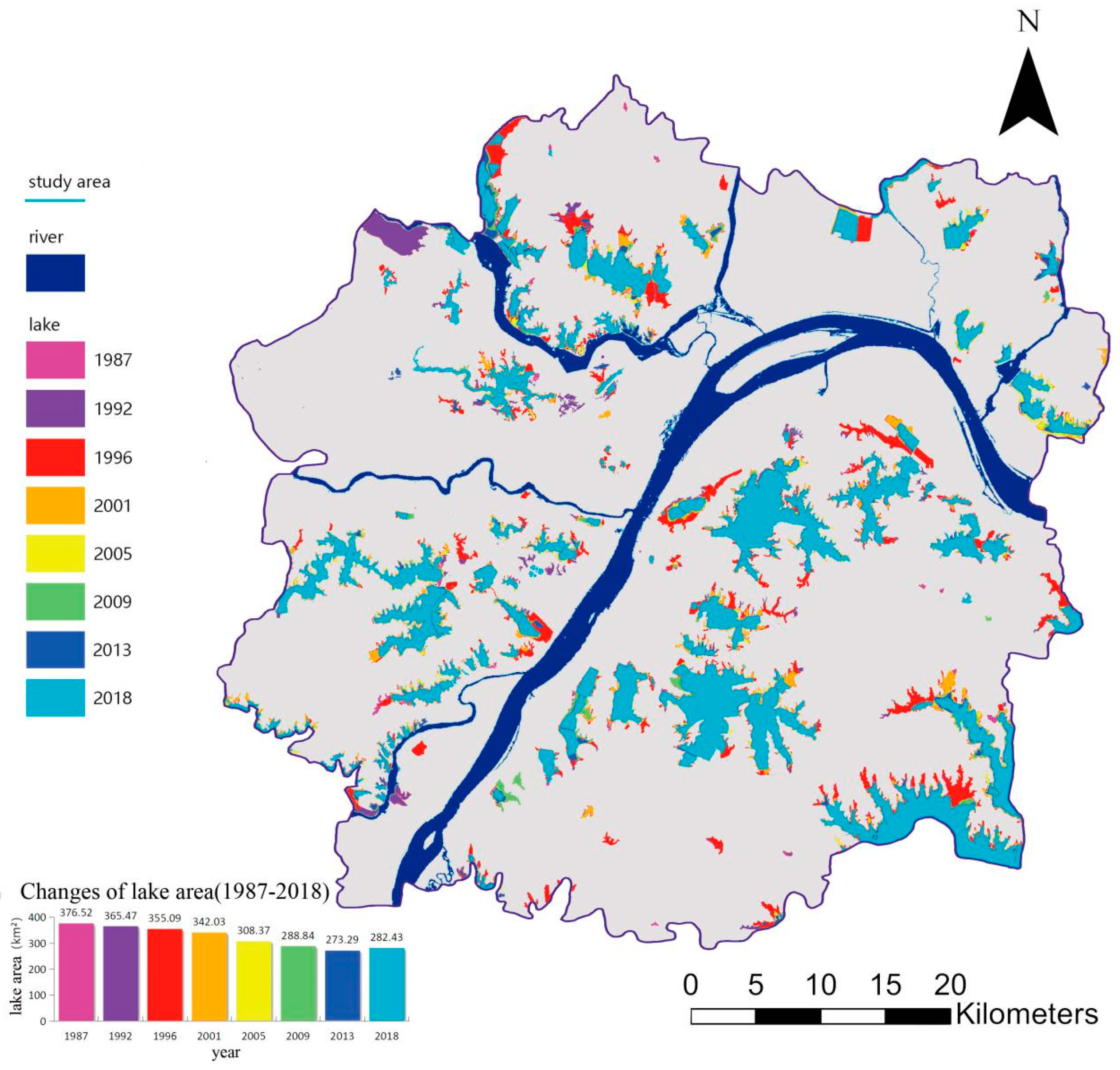

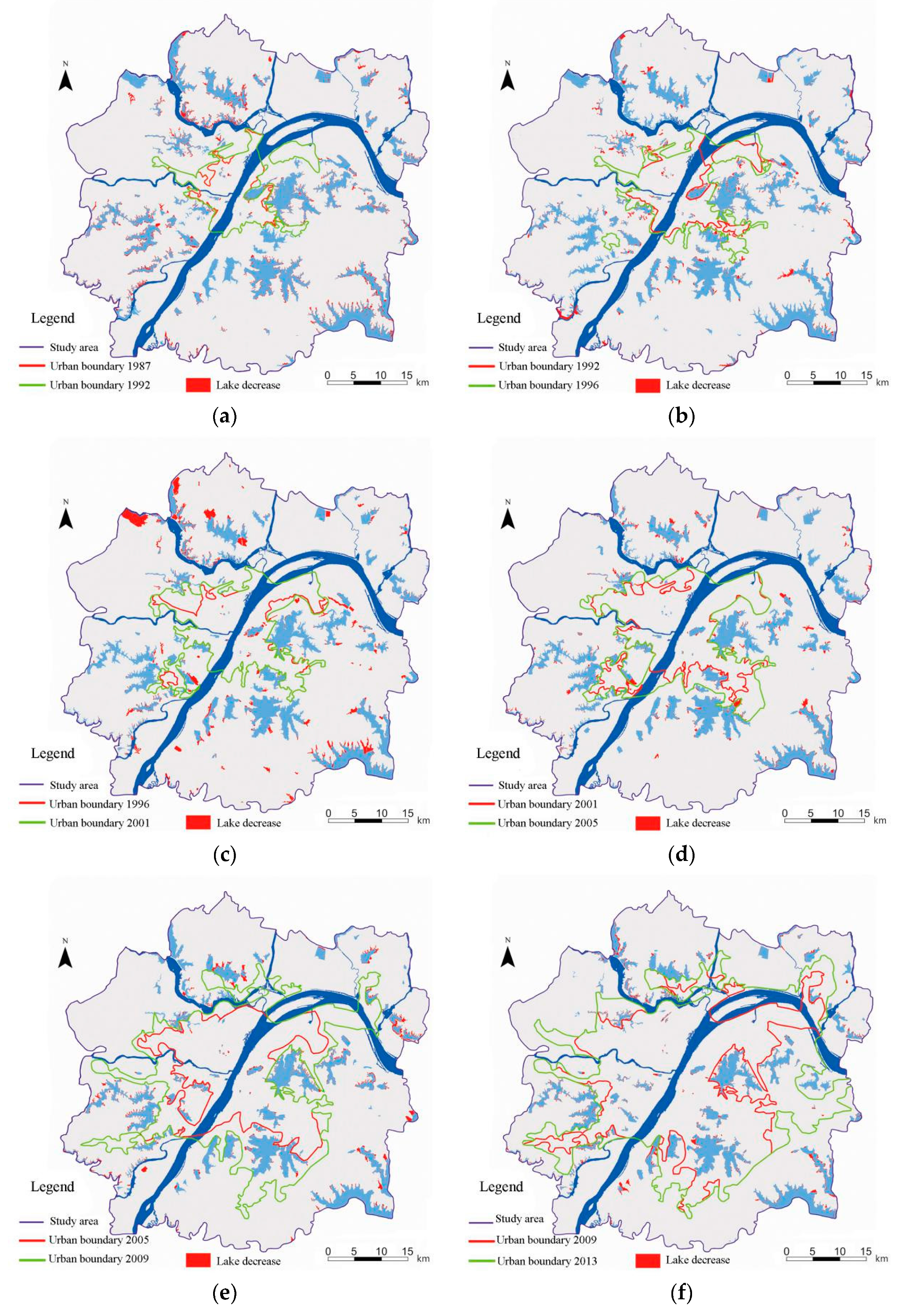
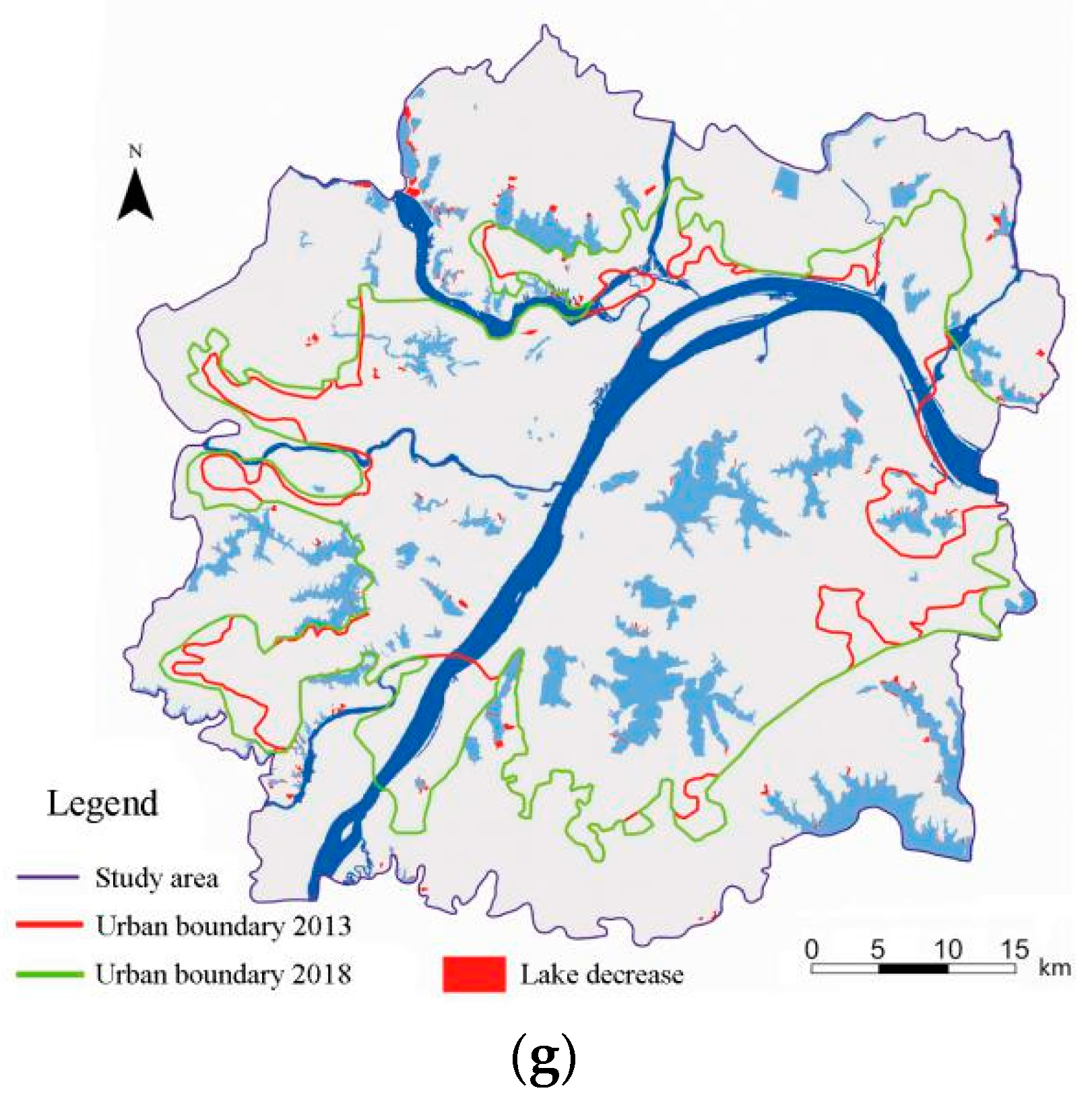
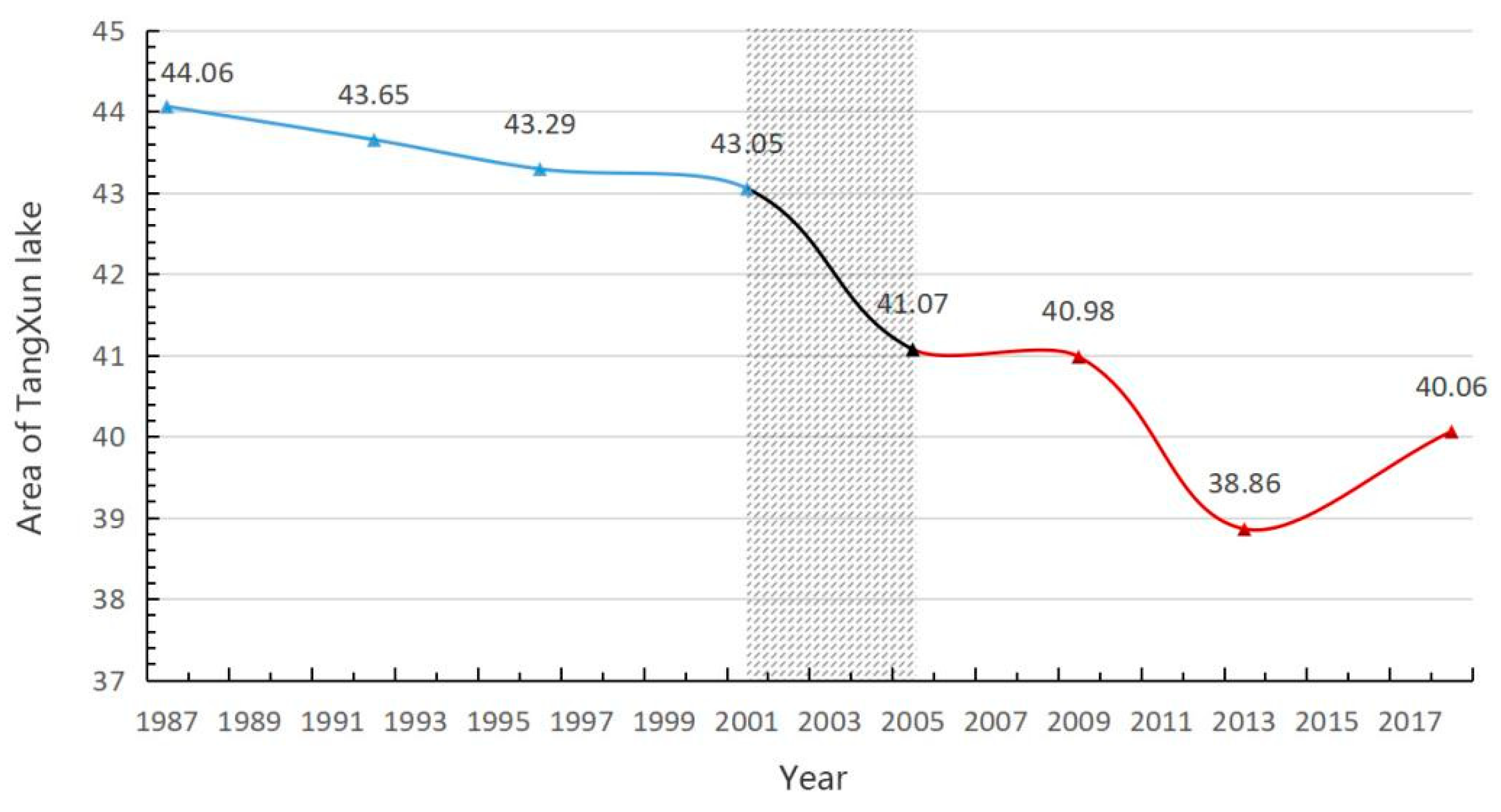

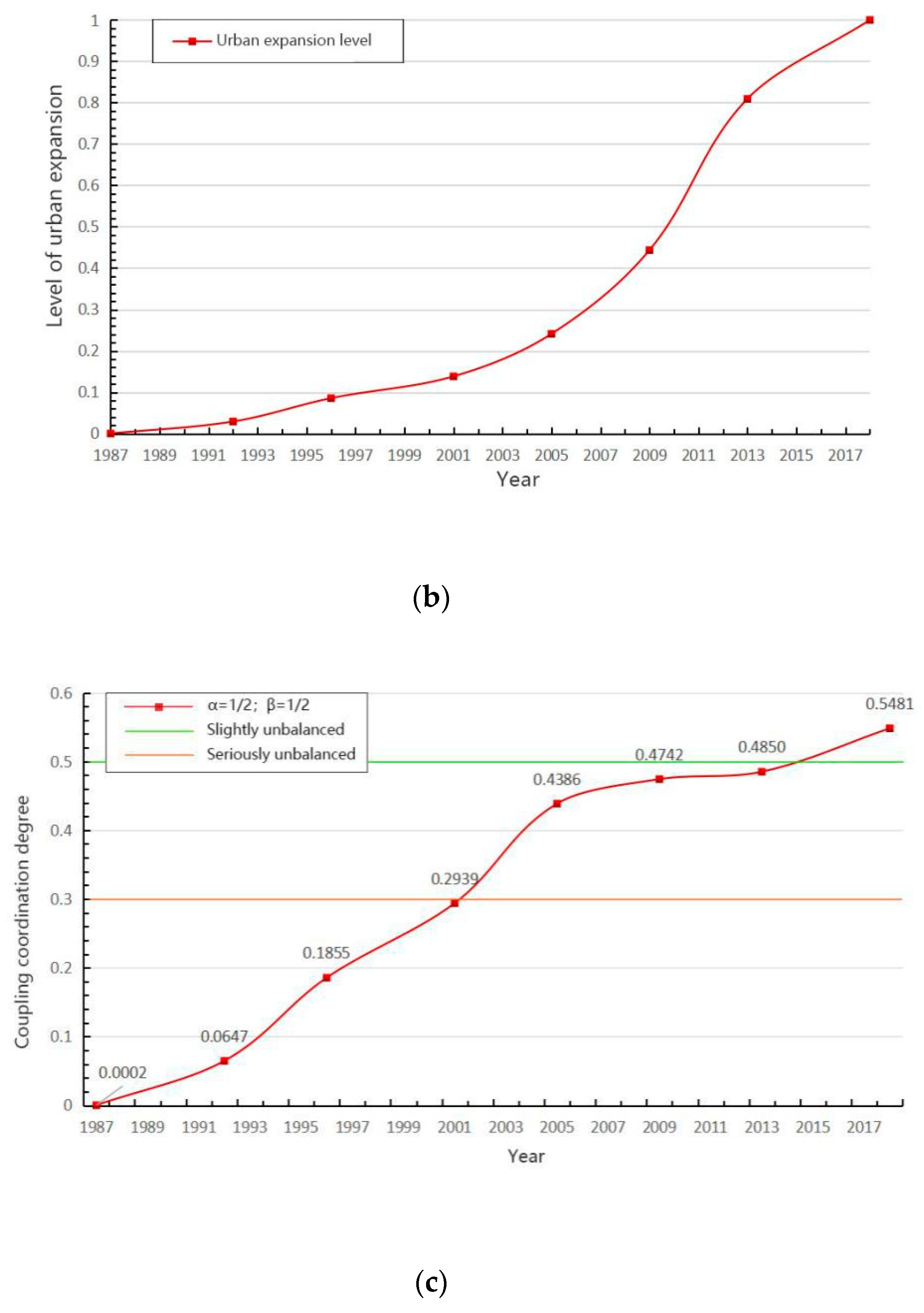
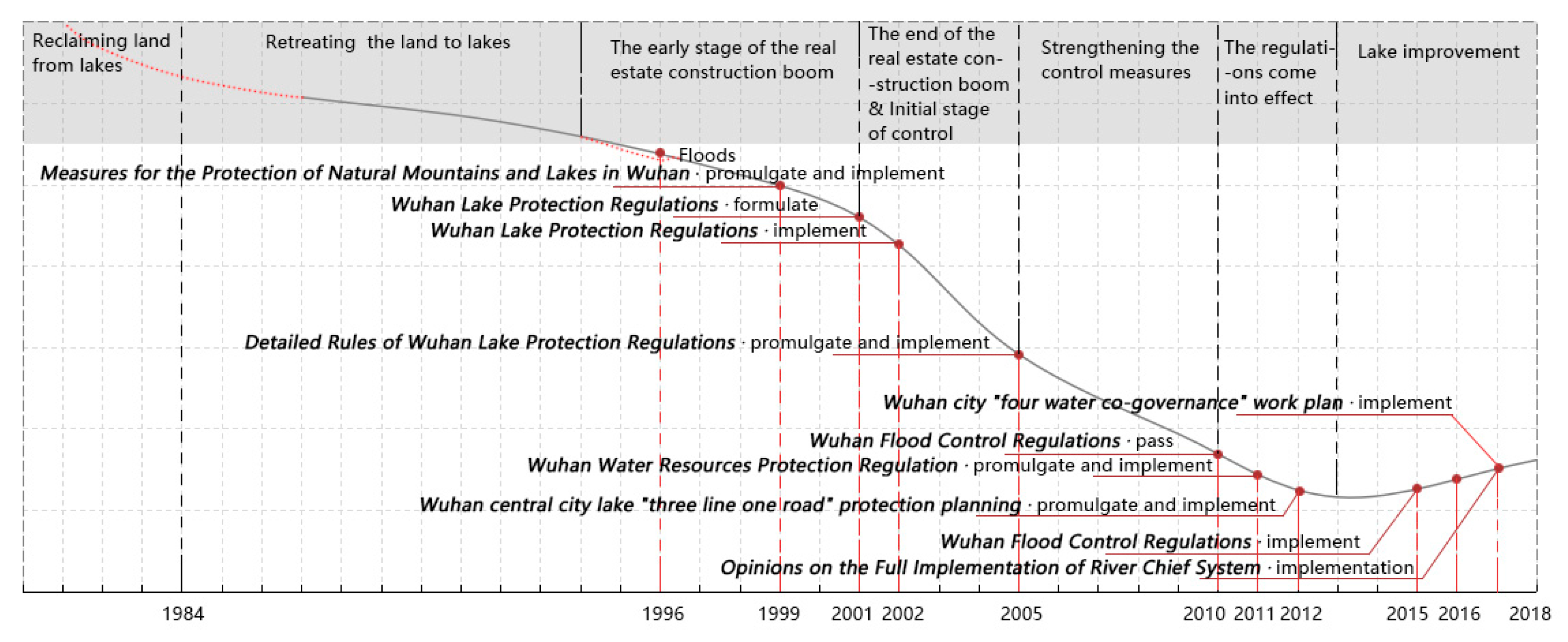
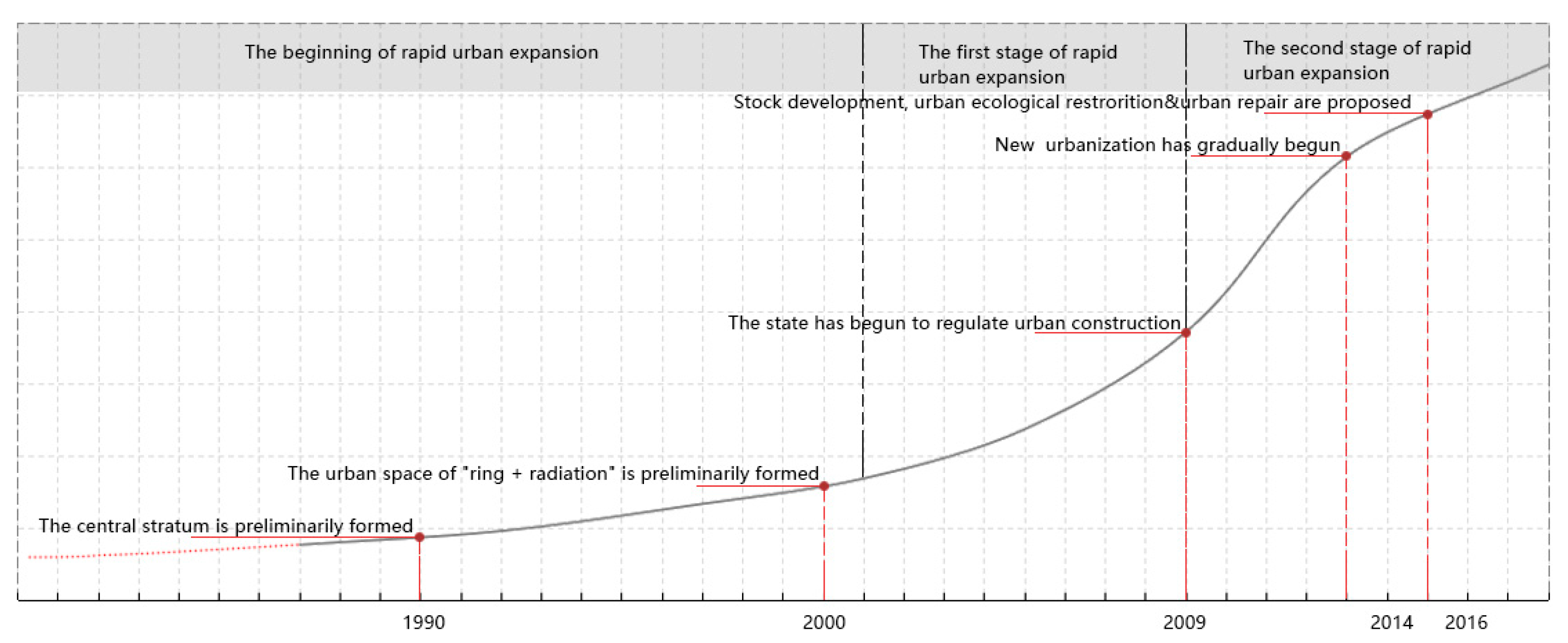
| Administrative Region | Lakes |
|---|---|
| Wuchang District | Sand, Ziyang, Shai, Fruit, Simei and East Lakes |
| Hanyang District | Moon, Lotus, Ink and Longyang Lakes |
| Qingshan District | North Lake |
| Hongshan District | Qingling, Huangjia, South, Ye, Yezhi, Yangchun, Tangxun, Bamboo, Qingtan, Yanxi and Yandong Lakes |
| Caidian District | West, Small Zha, Guanlian, Houguan, Zhiyin, Southern Taizi, Sanjiao, Lanni, Tang, Wanjia and North Taizi Lakes |
| Jiangxia District | Niushan and An Lake |
| Jiangan District | Wanzi and Tazi Lakes |
| Jianghan District | Machine Pond and North and Lingjiao Lake |
| Qiaokou District | Zhangbi Lake |
| Huangpi District | Hou, Tongjia, Majia, Maijia, Shizi, Renkai, Xinjiao, Panlong, Chang and Zhangdou Lake |
| Xinzhou District | Wu, Zhujia, Taoshu, Taojia and Chaibo Lakes |
| Satellite | Sensor | Resolution(m) | Data Identification | Date | Cloudage(%) |
|---|---|---|---|---|---|
| Landsat5 | TM | 30 m | LT51230391987253BJC00 | 10 September 1987 | 4.7% |
| LT51230391992027BKT00 | 27 January 1992 | None | |||
| LT51230391996278CLT00 | 2 September 1996 | None | |||
| LT51230392001067BJC00 | 16 September 2001 | 6.7% | |||
| LT51230392005110BJC00 | 11 September 2005 | None | |||
| LT51230392009249BJC00 | 6 September 2009 | None | |||
| Landsat8 | OLI | 30/15 M | LC81230392013260LGN01 | 17 September 2013 | None |
| LC81230392018098LGN0 | 8 April 2018 | 8.9% |
| Primary | Weight(%) | Secondary Indicators | Weight(%) |
|---|---|---|---|
| Lake change index | 61.25% | The average area of a lake(km2) | 44.59% |
| Average shoreline length(km) | 16.66% | ||
| Lake fragmentation index | 38.75% | Boundary density of lakes | 15.26% |
| Area-weighted shape index | 17.68% | ||
| Area standard deviation index | 5.81% |
| Primary Division of Development Stages | Secondary Division of Development Stages | Tertiary Division of Development Stages | ||
|---|---|---|---|---|
| Balanced development (acceptable interval) | 0.7 < D ≤ 1.0 | Superior balanced development | g(Y) − f(X) > 0.1 | Superiorly balanced development with lagging urban sprawl |
| f(X) − g(Y) > 0.1 | Superiorly balanced development with a lagging lacustrine environment | |||
| 0 ≤ |f(X) − g(Y)|≤ 0.1 | Superiorly balanced development of urban sprawl and lacustrine environment | |||
| Transitional development (acceptable interval) | 0.5 < D ≤ 0.7 | Barely balanced development | g(Y) − f(X) > 0.1 | Barely balanced development with lagging urban sprawl |
| f(X) − g(Y) > 0.1 | Barely balanced development with a lagging lacustrine environment | |||
| 0 ≤ |f(X) − g(Y)| ≤ 0.1 | Barely balanced development of urban sprawl and lacustrine environment | |||
| Unbalanced development (acceptable interval) | 0.3 < D ≤ 0.5 | Slightly unbalanced development | g(Y) − f(X) > 0.1 | Slightly unbalanced development with hindered urban sprawl |
| f(X) − g(Y) > 0.1 | Slightly unbalanced development with a hindered lacustrine environment | |||
| 0 ≤ |f(X) − g(Y)| ≤ 0.1 | Slightly unbalanced development of urban sprawl and lacustrine environment | |||
| 0 < D ≤ 0.3 | Seriously unbalanced development | g(Y) − f(X) > 0.1 | Seriously unbalanced development with hindered urban sprawl | |
| f(X) − g(Y) > 0.1 | Seriously unbalanced development with a hindered lacustrine environment | |||
| 0 ≤ |f(X) − g(Y)| ≤ 0.1 | Seriously unbalanced development of urban sprawl and lacustrine environment |
© 2019 by the authors. Licensee MDPI, Basel, Switzerland. This article is an open access article distributed under the terms and conditions of the Creative Commons Attribution (CC BY) license (http://creativecommons.org/licenses/by/4.0/).
Share and Cite
Wu, J.; Luo, J.; Tang, L. Coupling Relationship between Urban Expansion and Lake Change—A Case Study of Wuhan. Water 2019, 11, 1215. https://0-doi-org.brum.beds.ac.uk/10.3390/w11061215
Wu J, Luo J, Tang L. Coupling Relationship between Urban Expansion and Lake Change—A Case Study of Wuhan. Water. 2019; 11(6):1215. https://0-doi-org.brum.beds.ac.uk/10.3390/w11061215
Chicago/Turabian StyleWu, Jing, Jiameng Luo, and Lin Tang. 2019. "Coupling Relationship between Urban Expansion and Lake Change—A Case Study of Wuhan" Water 11, no. 6: 1215. https://0-doi-org.brum.beds.ac.uk/10.3390/w11061215





